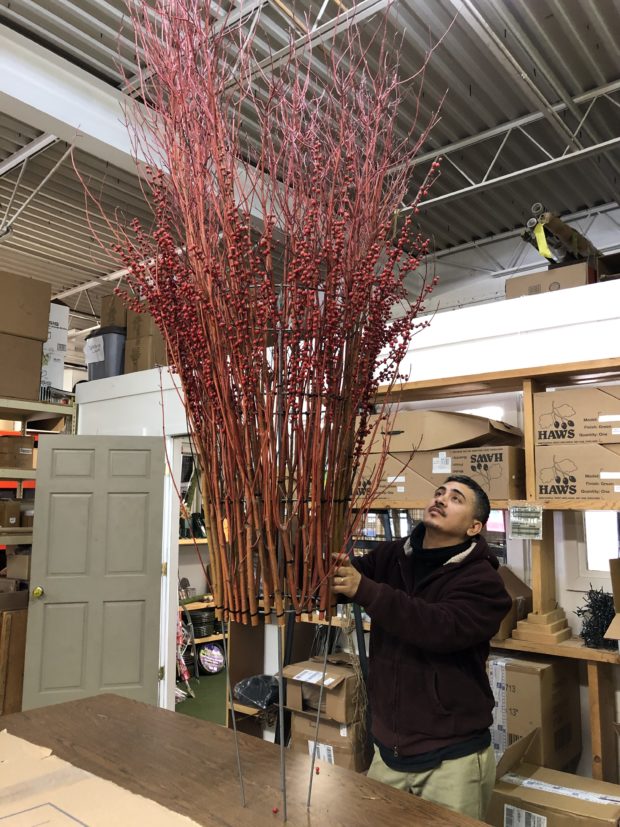 My post from November 11 concerning the construction of centerpieces for winter pots included this picture of Sal finishing the job of strapping very tall red twig dogwood branches and red berry picks to a tomato cage. It was obvious that a centerpiece of this size was destined for a very large pot. The substantial centerpieces would set the tone, size and proportion for all else that was to come. But what is to follow next is not so much about the mass and proportion required by large pots, but instead a discussion of that most ephemeral of all landscape design elements-light.
My post from November 11 concerning the construction of centerpieces for winter pots included this picture of Sal finishing the job of strapping very tall red twig dogwood branches and red berry picks to a tomato cage. It was obvious that a centerpiece of this size was destined for a very large pot. The substantial centerpieces would set the tone, size and proportion for all else that was to come. But what is to follow next is not so much about the mass and proportion required by large pots, but instead a discussion of that most ephemeral of all landscape design elements-light.
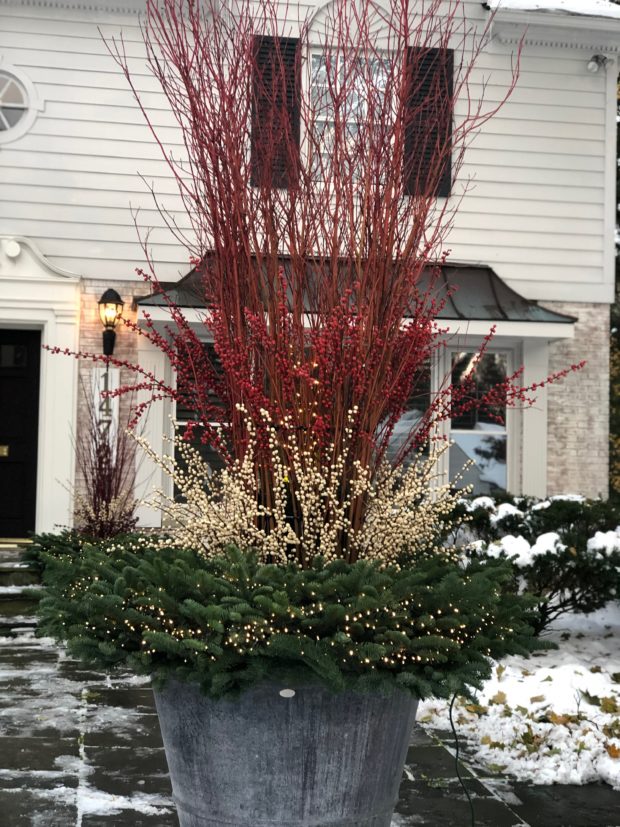 Gardeners are very aware that every plant has specific requirements for light to thrive. A fern will not prosper in full sun any more than a succulent will prosper in deep shade. The quality of light in a specific spot in a garden can vary significantly over the course of the day. I will plant hellebores in sunny locations if I can provide them extra water. Some sun loving plants are still willing to perform in part sun. There is that dance, matching a plant to the existing light conditions. I have been guilty of pushing that envelope too far. I may want a plant in a certain location, but time will tell whether the risk I took is a reasonable risk. Too far over the light line, and I have a failing plant on my hands. Every living thing needs light, to one indeterminate degree or another. But placing the plants in proper light spots in the garden issue aside, everyone benefits from an extra dose of light over the course of the winter.
Gardeners are very aware that every plant has specific requirements for light to thrive. A fern will not prosper in full sun any more than a succulent will prosper in deep shade. The quality of light in a specific spot in a garden can vary significantly over the course of the day. I will plant hellebores in sunny locations if I can provide them extra water. Some sun loving plants are still willing to perform in part sun. There is that dance, matching a plant to the existing light conditions. I have been guilty of pushing that envelope too far. I may want a plant in a certain location, but time will tell whether the risk I took is a reasonable risk. Too far over the light line, and I have a failing plant on my hands. Every living thing needs light, to one indeterminate degree or another. But placing the plants in proper light spots in the garden issue aside, everyone benefits from an extra dose of light over the course of the winter.
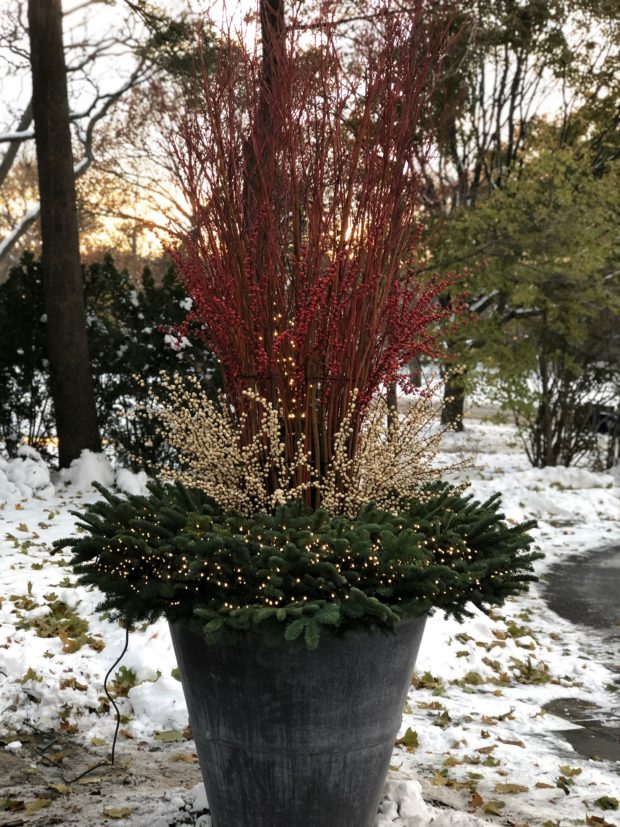 The winter containers are vastly easier to manage than a garden. The evergreen branches are cut. They will stay green the entire season, until warmer spring weather turns them brown. The cut dogwood branches will keep their color the entire winter, regardless of the light. Those branches may be inclined to push forth roots in the spring-astonishing, this. And the faux berry picks-they are faux. So the quality of light has no bearing on their performance. In sun or shade, they will provide visual service for years. The winter materials are not especially light sensitive. But we are! Winter container arrangements can provide any gardener with a spirit lift. I recommend them. An empty container over the course of the winter bothers me. I have no interest in being crushed by the winter season. I would rather find a way to celebrate it.
The winter containers are vastly easier to manage than a garden. The evergreen branches are cut. They will stay green the entire season, until warmer spring weather turns them brown. The cut dogwood branches will keep their color the entire winter, regardless of the light. Those branches may be inclined to push forth roots in the spring-astonishing, this. And the faux berry picks-they are faux. So the quality of light has no bearing on their performance. In sun or shade, they will provide visual service for years. The winter materials are not especially light sensitive. But we are! Winter container arrangements can provide any gardener with a spirit lift. I recommend them. An empty container over the course of the winter bothers me. I have no interest in being crushed by the winter season. I would rather find a way to celebrate it.
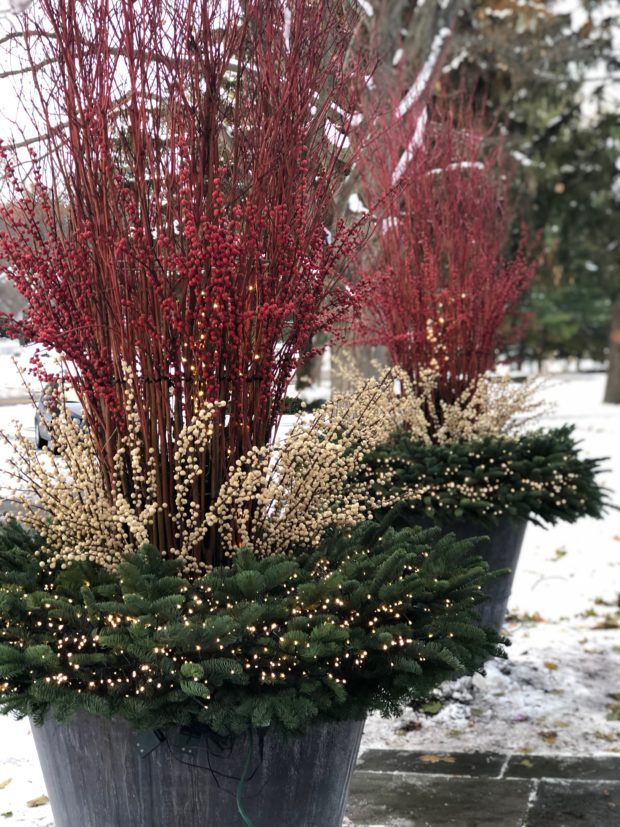 The quality of the winter light does affect people. Our winters are long, and feature snow, ice and wind. But most significantly, they are gray. Even a sunny winter day is over by the late afternoon. For the entire winter season, we have equal parts of light and dark. Or equally parts of gray and dark. That lack of light is demoralizing, and can make even the most good natured person cranky. This is why we feel lighting the winter pots is an essential part of their making. They need to be beautiful day and night.
The quality of the winter light does affect people. Our winters are long, and feature snow, ice and wind. But most significantly, they are gray. Even a sunny winter day is over by the late afternoon. For the entire winter season, we have equal parts of light and dark. Or equally parts of gray and dark. That lack of light is demoralizing, and can make even the most good natured person cranky. This is why we feel lighting the winter pots is an essential part of their making. They need to be beautiful day and night.
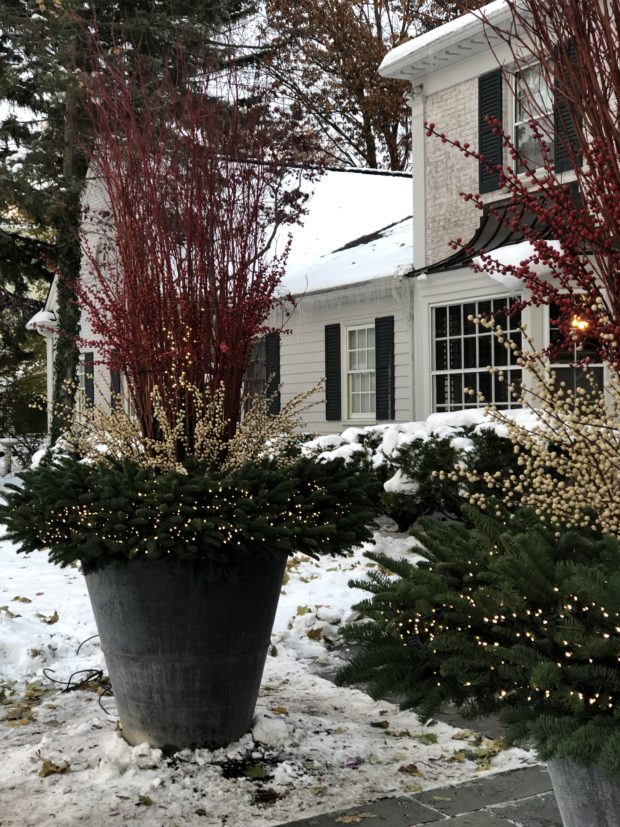 During the day, the color, texture and mass of a winter container provides visual respite from the landscape gone dormant. They push back against a garden that has gone quiet and frozen. It is not possible to recreate the spring summer and fall, but it is certainly possible to express remembrance. Every beautiful winter container makes me remember the beauty of the nature in full swing. The red twigs and berries are a welcome pop of color.
During the day, the color, texture and mass of a winter container provides visual respite from the landscape gone dormant. They push back against a garden that has gone quiet and frozen. It is not possible to recreate the spring summer and fall, but it is certainly possible to express remembrance. Every beautiful winter container makes me remember the beauty of the nature in full swing. The red twigs and berries are a welcome pop of color.
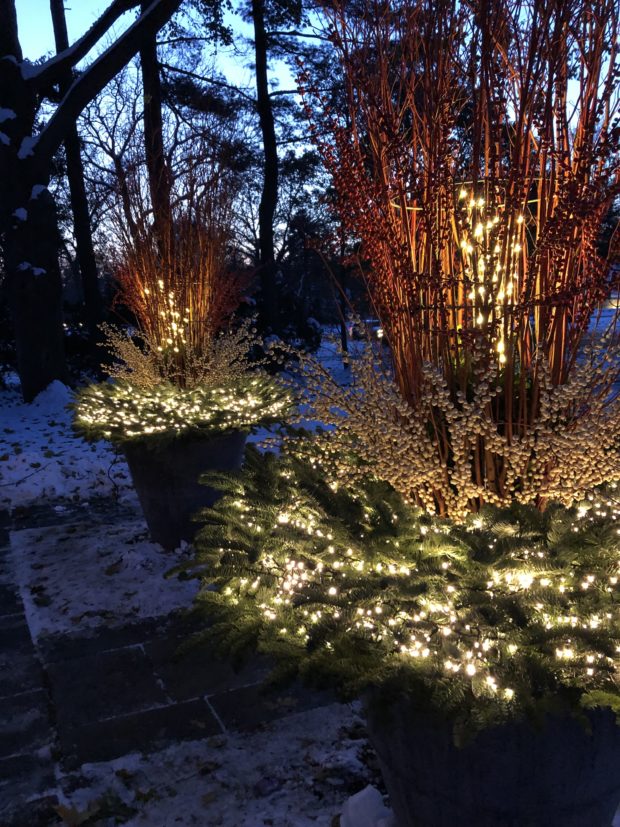 Dusk comes around 4pm every day in my zone. This is 5 more hours of dark than I have at the height of summer. Lighting in winter pots provide visual warmth, when there is little. They banish that relentless dark. They light the way to the door in a personal way. They can be an effective alternative form of landscape lighting. Night light is both cheery and dramatic. The invention of LED string and specialty lighting has revolutionized how we light pots. They require so little power that they are amazingly economical to run.
Dusk comes around 4pm every day in my zone. This is 5 more hours of dark than I have at the height of summer. Lighting in winter pots provide visual warmth, when there is little. They banish that relentless dark. They light the way to the door in a personal way. They can be an effective alternative form of landscape lighting. Night light is both cheery and dramatic. The invention of LED string and specialty lighting has revolutionized how we light pots. They require so little power that they are amazingly economical to run.
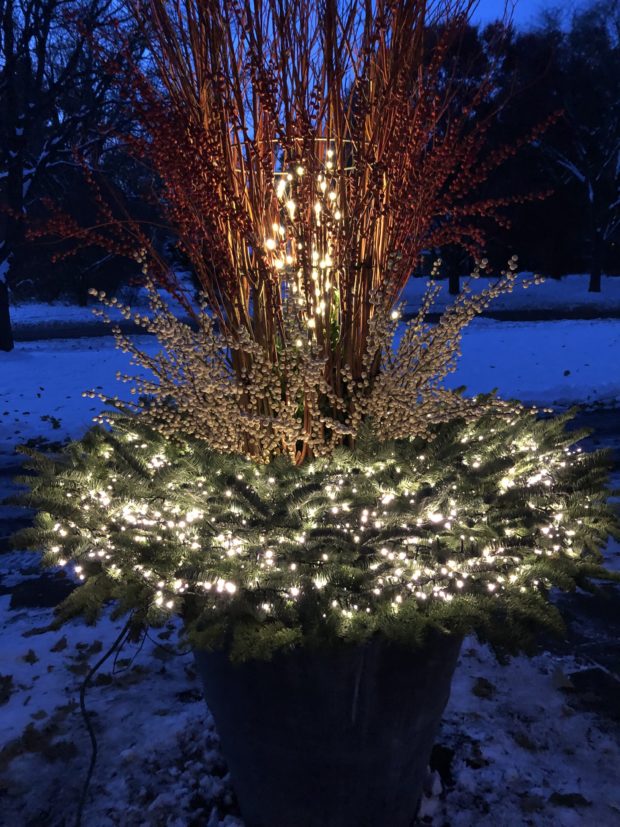 These pots at night are transformed by LED compact string lights. 1500 lights all on one strand that is 111.5 feet long. In the center is a Light Burst-a 3′ tall twig like contraption with moveable arms featuring an anchor at the bottom, and 240 brightly shining lights at the tips. Winter pots that are beautiful during the day need a mechanism for transforming them into their evening wear. This has never been easier to achieve.
These pots at night are transformed by LED compact string lights. 1500 lights all on one strand that is 111.5 feet long. In the center is a Light Burst-a 3′ tall twig like contraption with moveable arms featuring an anchor at the bottom, and 240 brightly shining lights at the tips. Winter pots that are beautiful during the day need a mechanism for transforming them into their evening wear. This has never been easier to achieve.
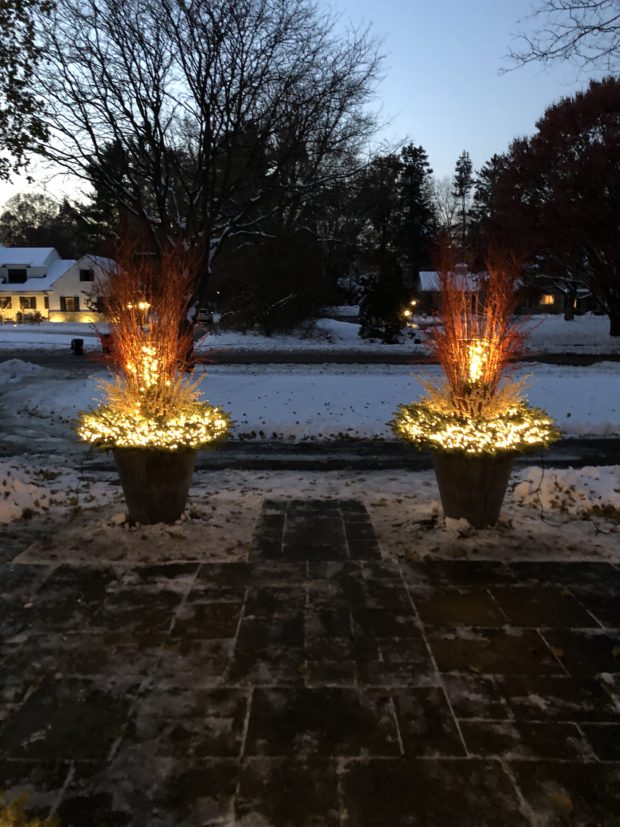 Cozy as a campfire, these winter pots at night are every bit as striking as their daytime appearance. The pots do a great job of illuminating the driveway drop off.
Cozy as a campfire, these winter pots at night are every bit as striking as their daytime appearance. The pots do a great job of illuminating the driveway drop off.
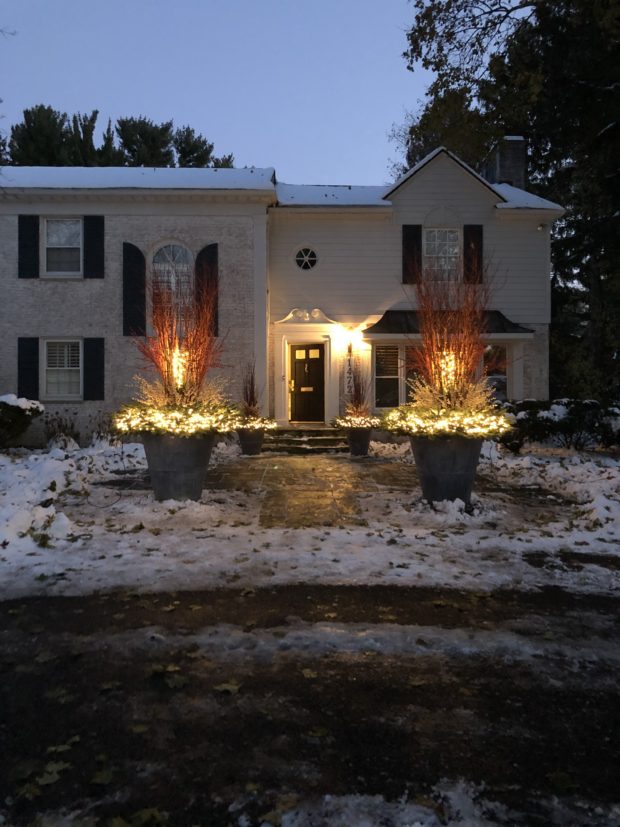
Deborah,
You should consider compiling these blog posts and photos into a book for gardeners. I can’t think of any other gardening book available that includes this kind of information and the detailed photos. I think some of the big publishers of gardening books would be interested. I guess you would need an agent first; I’m not sure of the procedure, but you definitely have all the material you need for a book proposal.
I second that suggestion!
Yes! Please!
I ditto that suggestion! A book please!!!!
Dear Deborah, I think about writing a book on and off. But if I did, it would be set in the context of landscape and garden design-of which containers are a part. all the best, Deborah
The pots are spectacular! What a welcome to guests as they arrive. The winter is long and dark and these beauties light up the night.
Your comments about gray and dark resonate for those of us in the Great Lakes region.
For your lighted pots, do you use battery operated lights or do you run electrical cords to outside outlets? If the latter, how are they disguised? Thanks.
Dear Kit, I do not use battery lights outdoors much-the batteries do not like the cold. Mostly the extension cords get routed in the most discreet way, and eventually the snow covers them. Black cords help. best, Deborah
I’ve had bad luck with using the faux berries – animals still attempt to eat them. Do you treat them with anything to deter such activity?
Dear Chris, I have never seen animals eat faux berries, although I have seen squirrels chew the wires on lights. If you are having a problem, then maybe you should stick with very hard plastic stems and berries. You could try a spray repellant – but I would test it on a small portion of the berry stem first. best, Deborah
Love your blog! How do you defrost the pots come March? I live in Chicago and have to drag my pots into our heated garage for a few days to thaw out until I can remove all the red sticks. These pots don’t look like they move.
Dear Laura, it can be a challenge getting the centerpieces out in the spring. But most of our materials are in drey floral foam-which does not absorb water, and therefore cannot freeze. best, Deborah
Hi Deborah. I live in Vancouver BC so our winters can be mild. I am in the process of decorating the outside for Christmas. i agree with you that lights offset the grey and dark but what it also does for me is extend the time I get to spend in the garden. I don’t put lights on the house (don’t want to do the ladder) but my gardens are filled. You are also right about not having to look at empty containers. So much fun and I am out there for hours.
I so love getting and reading your posts! Thank you for sharing so much great information with all of us.
Question: Do you remove all or part of the soil in these containers before installing the foam supported winter display?
Dear Joni, yes, we remove the top 2-3 inches of soil. best, Deborah
I love this, you have totally inspired me! How do you get string lights to each pot? Are they electric or battery operated?
Thanks for your blog, you are an artist!
Dear Mandy, we run extension cords to the lights from outlets outside the house. best, Deborah
Dear Deborah, your designs are an inspiration! I have been designing the pots for my church for a few years and find designing for Lent a challenge. I have used burlap to cover the soil and make it austere. Any suggestions?
Sweet blessings,
Addiz
OUTSTANDING!
A fiery warm welcome to the winter garden/home. Love it.
these are awe inspiring!! so beautiful thank you for the inspiration and information! God bless your generosity and creativity!
Do you have a link to those twig lights used in this planter?
This post is from 2019. That said, all of the lighting I use comes from Detroit Garden Works.